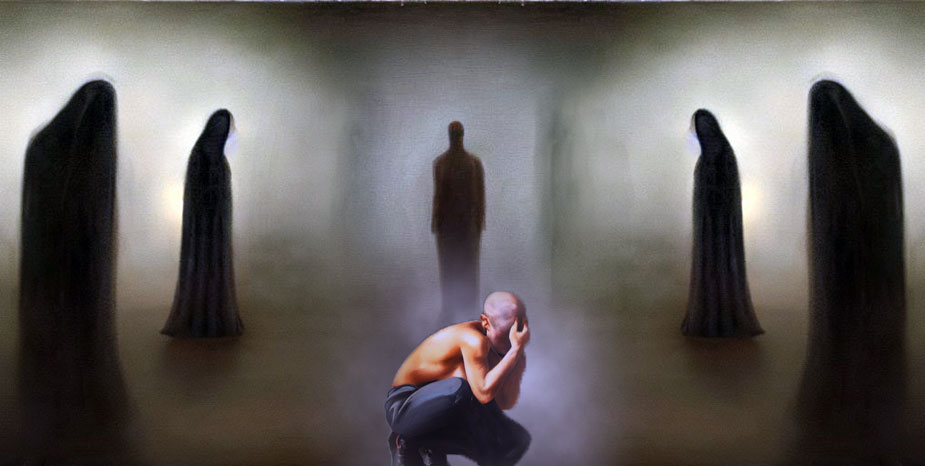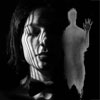Mental Illness: The Presence Of Spirits In Madness
 by Jerry Marzinsky, BA M.Ed
by Jerry Marzinsky, BA M.Ed
I offer this essay to affirm and update Dr. Wilson Van Dusen’s research on the voices schizophrenics hear which he presented in his chapter called The Presence of Spirits in Madness in his 1974 book “The Presence of Other Worlds”. His book validates the work of the eighteenth-century Christian Mystic, scientist and philosopher, Emanuel Swedenborg who produced volumes of profound documentation as a result of reaching into the depths of his own mind and spiritual worlds beyond. Van Dusen’s book inspired thousands to look more closely into Swedenborg’s work.
In their combined works both Wilson Van Dusen and Emanuel Swedenborg acknowledged that these Voices are conscious spirit beings and not hallucinations or the result of brain malfunctions. My clinical findings corroborate their work. In the process I have discovered important new information about the voices schizophrenics hear and how to weaken and get rid of them. These findings contradict the commonly held belief that paranoid schizophrenics suffer from hallucinations which are a result of a brain misfiring due to a chemical imbalance.
It was decades later while searching for a means to rid my schizophrenic patients of their voices that dealing with these entities became very frightening. There was no one I could speak to about what I was seeing and experiencing for fear of being labeled psychotic myself. Attempts to talk to my wife only terrified her. Speaking with my colleagues was out of the question. There were times I feared I was going mad.
Year’s prior while in graduate school I’d read Dr. Van Dusen’s book “The Presence of Spirits in Madness” about the conversations he had with the voices of his schizophrenic patients. It was in this work where he saw the marked similarity between the voices his patient’s were hearing and Swedenborg’s descriptions of evil spirits which substantiated what I was seeing. The voices were not hallucinations. I didn’t know if Dr. Van Dusen was still alive, but if he was, I had to find him.
My investigation into this area led me into strange territory for which I had no cognitive map nor did I know the rules. In hindsight, I do not think encountering these events was an accident.
I contacted Frank Rose, previous pastor of the Swedenborgian Church in Tucson who eventually put me in touch with Dr. Van Dusen.
We approached the investigation into the workings of these evil spirits from two different directions. Dr. Van Dusen’s approach focused on befriending and speaking with the voices in order to learn more about them. In contrast, I viewed the voices as evil and destructive forces that must be eliminated from my patients quickly and had never considered befriending them.
For almost two years prior to Wilson’s death, we utilized information gained by our respective approaches and fashioned different experiments to find out more about how these entities operated and how to interfere with their destruction of the schizophrenic patients they plagued.
DR. WILSON VAN DUSEN’S LEGACY
Wilson was the first clinical psychologist to discover that the voices his schizophrenic patient’s were hearing were indeed entities separate from the stricken individual. It was Dr. Van Dusen’s last wish that a book be written to make the world aware of the existence of these entities and bring to public attention that they were the driving force behind paranoid schizophrenia. He was so adamant that the book we started be completed that I kept feeding him information I was gathering on the front lines while he continued writing until he was too weak to type.
For more than a decade since his death, I’ve continued with the work we started and I am pleased to be able to add critical updated data to the information he presented in his book, “The Presence of Spirits in Madness.” We now know much more about the destructive voices which drive this mental disorder, how they operate and how to get rid of them.
It was Wilson Van Dusen who recognized that the voices his schizophrenic patients were hearing exactly matched the detailed descriptions Swedenborg gave for the evil spirits he encountered in his spiritual travels. Although he passed away before his theory about these voices could be proven, one of his final assertions was this: “If the voices could be gotten rid of by any means, all symptoms of paranoid schizophrenia would follow suit.” Thirteen years after his death I can say we have repeatedly proven this true.
In honor of Wilson Van Dusen and the insights he provided into the unseen schizophrenic world, for his bravery in publishing his findings, and having had the pleasure of knowing and working with him I humbly offer this new information that will most likely never be put forth through mainstream media or the medical establishment for the benefit of all. It was Wilson’s last wish that this be done. The information presented here will be anathema to mainstream psychology and psychiatry, which are loath to acknowledge spiritual influence upon human behavior. The material you will be reading here will give a never before seen view of what is actually going on within the psychotic mind and consequently, to different degrees, in the minds of all of us. Gathering this information took over 35 years on the battleground of working closely with potentially violent criminally insane prisoners and some of the most volatile psychiatric institutions in the country. This includes over 10 years spent working in the emergency rooms of major hospitals as a psychiatric evaluator dealing with explosive psychotic patients being dragged in by the police.
You will not find the information here in any university text.
INTRODUCING SHERRY SWINEY
Sherry is helping me write this material. She brings a unique and important perspective to this work. While Wilson and I have intensely studied the voices pretty much from the outside looking in, Sherry has experienced them from an insider point of view, as did Swedenborg. As a young woman she struggled with these deadly psychotic voices for decades, at times holding onto sanity by a thread.
I met Sherry over 20 years ago while working in the psychology department in a large state prison. She had built one of the largest prison reform websites in the country. Her day job was working as a civil construction engineer managing multi-million dollar projects all across the country. We worked together on prison reform issues for ten years until one day I began talking about the bizarre behavior of my schizophrenic patients who had listened to their voices and got into trouble. Sherry replied that she knew all about the voices. She called them entities. As a young woman, she’d fought a horrific battle with the evil spirits and won. She did this without soliciting help from psychiatry or psychology and without taking any anti-psychotic drugs. With this revelation about her, our friendship took a different turn. Her story is fascinating and scattered throughout this paper.
During one of the lowest points in her life while undergoing constant attacks from these entities, Sherry tenaciously researched the literature for anything that could explain what was happening to her. At the same time she struggled to complete a college degree in business administration and was taking courses in civil engineering. Even though how the mind operates remains a scientific mystery, one thing was certain for Sherry: the entities attacking her mentally were not hallucinations.
TYING SCIENCE AND SPIRITUALITY TOGETHER
At the age of fifty Swedenborg, one of the most accomplished scientists and scholars of his day abruptly terminated his prodigious study of physical science and mathematics with the realization that the sciences transitioned into the spiritual world. His efforts from that point on were directed toward understanding how the spiritual world operated and how those operations affected the minds of men. When science reaches the end of the material world, it has to go beyond if it is to continue searching for truth. Swedenborg’s foray into the spiritual world shows a remarkable harmony with current discoveries in biology, physics and quantum science. For example:
In quantum science, the term nonlocal refers to phenomena taking place outside of the three dimensional realm. Dr. Joe Dispenza a noted neuroscientist brought forth the notion that: “nonlocal communication between systems suggests that the light [a frequency] emitted from our cells may carry information which transcends current mainstream thought about how our biological systems work.
In spirituality, nonlocal would refer to heaven or hell as found in one of Swedenborg’s most famous works, “Heaven and Hell – From Things Seen and Heard” originally published in 1758 wherein Swedenborg discovered that God’s Holy Word contains deeper levels of meaning, which allow it to convey inexhaustible knowledge. These deeper levels of meaning, jump back toward their origins, lawfully abstract and free themselves from their involvement with time and space. Therefore, the Holy Word, which first existed in a nonmaterial heaven, has a nonlocal and pre-Planck dynamic.
In this update, the term nonlocal refers to conscious beings both negative and positive that exists just beyond our visual range and has a long history with humans on Earth. Few have seen them but many have sensed their presence – their energetic frequency – and millions have heard them in their minds most appearing as their own thoughts. Sherry maintains that every negative thought about ourselves is an insertion by the negative entities attempting to generate the negative emotional energy on which they feed and that these attacks are upon all of us. In their most extreme form these negative entities can be witnessed in the vile voices paranoid schizophrenics hear which have been mistakenly dubbed as hallucinations by the educational and mental health communities. On the opposite side of the spectrum exists powerful positive entities which are commonly referred to as the Little Voice Within which require a calming of the mind to clearly hear, urging the individual toward the pursuit of a positive spiritual path. The opposing conditions leave man in a neutral balance permitting him to choose in which direction he would like to move.
WILSON’S CHAPTER – THE PRESENCE OF SPIRITS IN MADNESS
Dr. Van Dusen presents a number of cases where his work as chief clinical psychologist in a California psychiatric hospital led to his conclusion that the voices schizophrenics were hearing proved to be conscious entities independent of the patient with whom he could carry on conversations and ask questions. In the series which follows, we will present first what Dr. Van Dusen discovered then move on to update his information with what we have found in the thirteen years of clinical study of the voices after his death as to the patterns the voices run and how they operate. An understanding of how the voices operate is critical to ridding the millions of people whose lives have been taken over by these entities to free themselves. It is also critical to understand that we are all being attacked by these beings constantly and to different degrees. The current state of our planet, the constant warring, TV shows that present a nonstop stream of murders and shootings and a never ending plethora of negative news is hard evidence as to how effective these entities are when science and society deny their existence and allow them to operate unimpeded.
Van Dusen
By an extraordinary series of circumstances a confirmation appears to have been found for one of Emanuel Swedenborg’s more unusual doctrines—that man’s life depends on his relationship to a hierarchy of spirits. Out of my professional role as a clinical psychologist in a state mental hospital and my own personal interest, I set out to describe as faithfully as possible mental patients’ experiences of hallucinations. A discovery four years ago helped me to get a relatively rich and consistent picture of the patients’ experience.
Update – Jerry Marzinsky
How the human mind operates has eluded the conventional medical model which stipulates that man is little more than a biological machine driven by the firing of neurons and chemical reactions.
It should be noted that one major aspect of what Van Dusen considers hallucinations are the voices paranoid schizophrenics hear.
Van Dusen
Though I noticed similarities with Swedenborg’s description of the relationships of man to spirits, it was only three years after all the major findings on hallucinations had been made that the striking similarity between what Twentieth-Century patients describe and Swedenborg’s Eighteenth-Century accounts became apparent to me. I then collected as many details as possible of his description. I found that Swedenborg’s system not only is an almost perfect fit with patients’ experiences, but even more impressively accounts for otherwise quite puzzling aspects of hallucinations.
I will first describe how I worked and my findings, and then relate this to Swedenborg’s work.
All the people involved hallucinated. They included chronic schizophrenics, alcoholics, brain-damaged and senile persons. The subjects of this study came to the attention of friends or the public because of unusual behavior. The average layman’s picture of the mentally ill as raving lunatics is far from reality. Most of these people have become entangled in inner processes and simply fail to manage their lives well. In the hospital most have freedom of the grounds and the average visitor is impressed that, aside from occasional odd bits of behavior, the patients have most of their powers and appear like almost everyone else. Many return home in a month or two, never to need mental hospitalization again. Some become so enmeshed in inner processes that they slip to lower levels of mental disorder.
Update by Jerry Marzinsky
Although paranoid schizophrenia is the class of schizophrenic disorder where the voices are most prevalent, it is one of the most common. There are many different types of schizophrenia a number of which are not responsive to the information and treatment methods presented here. Among these are the psychotic delusional disorders which are particularly difficult to treat by any means. The findings and information contained here pertain to and are specifically relevant to the treatment of paranoid schizophrenia, a condition where the patients mind is being invaded by compulsive, negative, derogatory, self-defeating and self-destructive thoughts which are virtually identical to the demonic spirits described in Swedenborg’s writings.
Van Dusen
Most conceal that they hear and see things because they are wise enough to know the visitor doesn’t and wouldn’t understand.
Update by Jerry Marzinsky
Wilson brings up a key point here which took me years to fully comprehend. Schizophrenics soon learn that others around them cannot hear the voices that are speaking to them, often abusing or sometimes yelling at them. Attempts to tell others of the vile voices that plague them only serve to frighten and deeply concern friends, family and relatives who begin to view them as sick, crazy, odd, spooky and frightening or possessed. Many find that after telling their families they are hearing voices, they are taken to a psychiatrist who pronounces them insane, tells them their voices are not real, their brain is broken and that they are hallucinating.
The drugs prescribed to them often act as major tranquilizers which turn them into semi-zombies. They learn the hard way that there is no positive outcome in telling others about these voices and for this reason they tell no one what they are going through and they isolate themselves.
In Sherry’s case, she was raised in isolation for the first six years of her life and in those years, she was the subject of experimental torture methods and was never allowed to voice her thoughts. The few times she did, such as asking where thoughts came from and what happened to them once were released, she was reminded that no one asked such crazy questions. She grew up knowing that no one was interested in those kinds of things, so she did not discuss her intrusive thoughts with anyone, even as she grew to adulthood. In fact, she did not speak of her experiences with anyone until she learned of my work and finally talked about them with me ten years after we met.
Many of my patients reported that their voices encouraged such isolation by telling them they can’t trust anyone and that others are out to get them or kill them. They can hold coherent conversations with their voices.
Gaining the patients trust is essential to any serious researcher studying the voices. When I gave them the benefit of the doubt they were much more willing to speak about their experiences.
When they finally find someone who understands what they are experiencing, they open up with an unbelievable gratitude and eventually a plethora of information.
Van Dusen
None of the patients, at the most severe level of mental disorders could be included in this study because they couldn’t describe their hallucinations well enough.
After dealing with hundreds of such patients, I discovered about four years ago that it was possible to speak to their hallucinations. To do so I looked for patients who could distinguish between their own thoughts and the things they heard and saw in the world of hallucinations.
Update by Jerry Marzinsky
I found that the patient being able to distinguish between their own thoughts and those of the voices was critical to their recovery. Sherry found this ability to be important to discovering what these invasive thoughts were and how to remove them from her life.
Several patients strongly suspected the voices they were hearing did not belong to them despite the fact that they sounded like their own thoughts. They realized at some level that what they were hearing did not correspond to their own intent for themselves.
Patients who came to the conclusion that the voices do not belong to them were more likely to recover than patients who believed their voices were not separate from themselves or were hallucinations.
After many years trying to figure out what was going on with my patients, I had no one to talk to who would understand other than those considered insane. Sherry was a sane person whom I could open up to safely. I was greatly relieved to see that our findings significantly meshed. A powerful weapon Sherry developed to fight back against the entities was similar to a system I’d been using to attack their same vulnerabilities but proved simpler and easier to use.
I extensively tested her “That’s a Lie Program” on psychotic prisoners and found it easier for them to remember and utilize.
Van Dusen
The patient was told that I simply wanted to get as accurate a description of their experiences as possible. I held out no hope for recovery or special reward.
It soon became apparent that many were embarrassed by what they saw and heard and hence they concealed it from others.
Update by Jerry Marzinsky
Many of my patients were also reluctant to discuss aspects of the most grotesque messages. The content of their voices often disturbed, shocked, upset or frighten the patient into a negative emotional state. The more frenzied the emotional state, the more negative energy was generated.
Sherry says: “During the period of time when these dark spirits invaded my consciousness, they inserted unimaginably painful, guilt-provoking, derogatory and self destructive thoughts into my mind. Their constant assaults hurled me into a deep depression and a confusing, surreal reality for years. The thoughts that appeared in my mind were so negative and alien to all I knew about myself and how I felt about things. I dared not seek the help of a psychiatrist for fear of being drugged senseless and sent to a mental institution. I had no one I could speak to about what was happening who would even remotely understand.”
“I saw no option other than to figure out where these thoughts were coming from and how to get rid of them on my own. I had a strong background in computer programming and a basic knowledge of the electro-chemical workings of the brain. I reasoned that I might be able to program my mind in a similar fashion to how I programmed computers.”
Her struggle to confront these deadly attacks without psychiatric or any other outside help was lonely, risky, dangerous and uncertain.
Sherry says: “I felt the endeavor was akin to climbing Mount Everest alone in a winter blizzard. Stubborn and vigilant, I was determined to figure out where the invading thoughts that relentlessly badgered me came from and how to free my mind of them. At times I felt crushed by the dark spiritual muck being poured like thick molasses over the small spark of soul I sensed was still in me.”
“I listened to the voices saying, ‘The fence line is thin, isn’t it? You know it would be so much easier to take one step to this side where you can relax, just give in and let yourself go crazy. People will take care of you. No more fighting. No more pain. No more worries. You’ll be okay then.’ ”
“I was tempted as well as frightened that I might succumb. I concentrated on the tiny light in me that was trying to stay lit and told myself to get up and keep going; that there was an answer and I was going to find it or die.”
“What I learned about these debilitating spirits during my life threatening struggle has been priceless to me and many others who have been willing to listen.”
“I experimented with different ways to mentally overwrite my previous negative programming. Every time the voices inserted a negative thought about me into my mind, I responded with, ‘That’s a Lie’ and immediately rejected it. I noticed that if I consistently stuck with this program, the disturbing thoughts began to weaken and lose ground. As I was slowly able to regain some of my life force back, I was further able to replace negative thoughts with more positive ones. This further weakened the entities. The result allowed me to formulate a clear idea of what had happened to me, what the voices were and how they operated. Putting this knowledge to use, I accomplish something psychiatry insists is impossible: I got rid of the voices on my own without any of their toxic medications.”
Van Dusen
It took some care to make the patients comfortable enough to reveal their experience honestly.
A further complication was that the voices were sometimes frightened of me and themselves needed reassurance. I struck up a relationship with both the patient and the persons he saw and heard. I would question these other persons directly, and instructed the patient to give a word-for-word account of what the voices answered or what was seen. In this way I could hold long dialogues with a patient’s hallucinations and record both my questions and their answers.
My method is that of phenomenology. My only purpose was to come to as accurate a description as possible of the patient’s experiences. The reader may notice I treat the hallucinations as realities because that is what they are to the patient. I would work with a patient for as little as one hour or up to several months of inquiry where the hallucinated world was complex enough.
Update by Jerry Marzinsky
My goal was to interfere with the messages the voices were giving my patients so I could help my patients get well. I knew they did not fit the clinical definition of hallucinations. My patients saw the voices as real just as Wilson’s patients did.
Sherry calls them entities and thinks of them as alien thoughts. They didn’t belong to her and she didn’t know where they came from. Swedenborg called them evil spirits. By comparison, mainstream establishment is not interested in learning what the voices are.
Sherry says: “Look around, we live in a society under siege by an unseen dangerous enemy. It is critical that we comprehend that not all of our thoughts are our own. We have all experienced negative thought insertions and have most likely ignored it. It is clearer when out of nowhere a horrible, vicious, demeaning or harmful thought barges into our consciousness unrelated to anything we were previously thinking. Such thoughts are infrequent but are clearly felt by the experiencer as bizarre and bone chilling. These are thoughts that surprise us. Most of us just shake such incidents off somewhat shocked that such an awful idea lunged into our awareness.”
“These mental invaders strive to instill paranoia, guilt and anxiety. I eventually learned to send them the frequency of Cosmic Love. This is very different from romantic love, friendship love, neighborly love or family love. It is a frequency that involves no emotions. The easiest way I have found to do this is to simply and calmly say: ‘I send you love.’ I could not say this from a state of fear, anxiety, worry, anger, or any other negative emotion because that did not work. I had to mean it. They found this intolerable and it prevented them from inserting negative thoughts into my mind. Their inability to do this deprived them of their food. They had to leave or starve.”
In Swedenborgian terms, this could be called “the struggle for the mind.” Swedenborg felt that none of our thoughts are our own. He believed thoughts flowed into our minds from positive or negative entities outside of ourselves and that we are the choosers of which thoughts we entertain much like tuning into music we prefer on a radio station.
To continue reading see full pdf download here.
Schizophrenia, Possession and Freedom – with Jerry Marzinsky
The Experience of Entities (Additional Segment of Jerry Marzinsky Interview)
Additional Podcast
Posted in Health, Other Topics, Spiritualitywith comments disabled.





